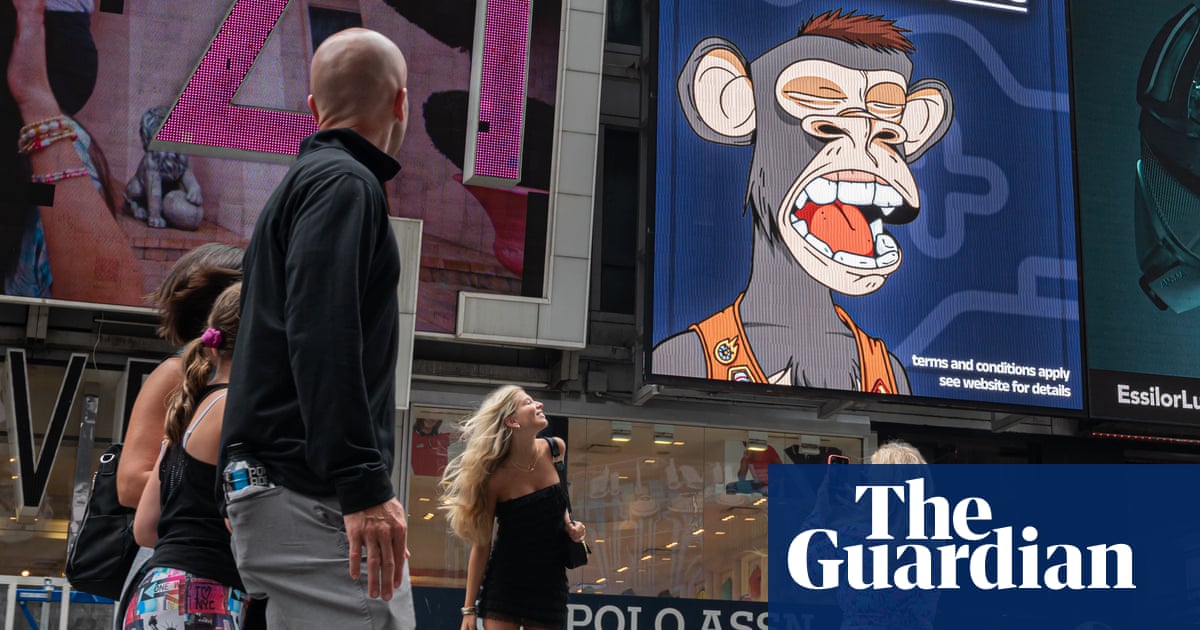A new service offers a way to offset losses from NFTs during a grim crypto winter that saw demand for digital collectibles vanish
Just a year ago, Washington DC’s Hirshhorn art museum – the capital’s preeminent contemporary art museum – was asking whether non-fungible tokens (NFTs) were “fad or the future of art”. Twelve months on, it looks like “tax write-off” might have been the right answer.
This year was not just the year that cryptocurrency values were burned by investor fears, rising interest rates, inflation and scandals, it was the year that crypto’s cartoonish art cousin the NFT – an electronic identifier confirming a digital collectible is real – collided with reality.
In March 2021, Christie’s sold a digital collage NFT by the artist Beeple for nearly $70m (£58m). In January pop star Justin Bieber paid $1.29m (£1m) for a “Bored Ape” NFT, a graphic of a, well, bored ape. Everyone from Michael Jordan to former first lady Melania Trump was in on the game.
Now – alongside the broader crypto market – the appetite for NFTs is so diminished that a specialized market has sprung up for collectors looking to sell off their once-valuable “digital collectibles” as tax losses to offset their income tax bills.
A recently launched service, Unsellable, aims to help collectors do exactly that. Think of it as a distressed asset fire sale.
“While every investment class has its losers, many of the NFTs we invested in were not only down big; they were now totally worthless … illiquid … unsellable,” the service says on its website.
Unsellable – which says it is “building the world’s largest collection of worthless NFTs” – buys the underlying tokens for a fraction of their original price and provides an official receipt for tax purposes.
Launched a month ago, Unsellable now has 5,000 NFTs, and founder Skyler Hallgren expects that to grow to 15,000 by the end of the month. “They are an interesting artefact of a period of time in the market,” he said. But he expects the NFTs are “likely to continue to be worthless”.
“We realized there was a practical problem that was locking up a lot of resources and we could create a lot of value for people by offering to buy up their worthless NFTs and allow them to harvest the losses,” said Hallgren.
“For some folks, the amount they paid for NFTs is quite high and were buying them for a penny so the write-off they can take is quite high.”
It’s easy to see why buyers may be keen to sell for a fraction of their original investment. Demand for digital certificates of ownership that underlie NFTs has evaporated. More than $19bn (£16bn) was spent on NFTs between January and March 2022. Since then, according to blockchain analysis firm Chainalysis, monthly spending has dropped by 87%.
Just $442m (£368m) was spent in November, and the number of active NFT traders is down around two-thirds from its peak a year ago. According to the Nonfungible.com market tracker, 144,000 NFTs were sold for $142m (£118m) on 16 January 2022. This Wednesday, there were 17,000 sales for $28,000 (£23,294).
The most traded collection of NFTs are images from the Bored Ape Yacht Club (BAYC), like the one Bieber bought. Each Bored Ape image features a unique combination of 170 possible traits, including expression, headwear, clothing and more. “All apes are dope, but some are rarer than others,” the company says.
Sign up to Business Today
Get set for the working day – we'll point you to the all the business news and analysis you need every morning
Yuga Labs, the company behind Bored Ape, was recently hit with a class-action lawsuit claiming it had unrealistically hyped the value of its intangible goods. The lawsuit named celebrities – and former NFT evangelists – including Bieber, Paris Hilton, Madonna, Jimmy Fallon and Kevin Hart, as co-defendants.
“Defendants’ promotional campaign was wildly successful, generating billions of dollars in sales and re-sales,” the lawsuit, filed on 8 December in a district court in California, said.
“The manufactured celebrity endorsements and misleading promotions regarding the launch of an entire BAYC ecosystem (the so-called Otherside metaverse) were able to artificially increase the interest in and price of the BAYC NFTs during the relevant period, causing investors to purchase these losing investments at drastically inflated prices.”
The NFT market is a long way from where it sat in October 2021, when Mike Winkelmann – the digital artist known as Beeple – sold his work at Christie’s, making him “among the top three most valuable living artists”.
Last week, Winkelmann remained upbeat about the internet’s place in creating art, but he conceded: “The market is a bit crap right now,” he told Bloomberg. “Do I think it’s going to go back to where it was? I don’t know … I definitely think it’s going to go up from here.”
And one former celebrity, and US president, agrees. Earlier this month, Donald Trump launched a collection of digital collectibles depicting him as, among other things, an astronaut, a cowboy and a superhero. It sold out in less than a day.
Author
Administraroot


